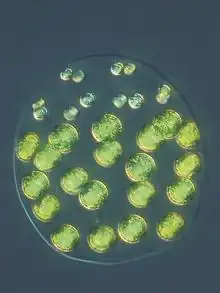Pleodorina starrii
Pleodorina starrii is a species of algae that resides in freshwater in Japan.[1]
| Pleodorina starrii | |
|---|---|
 | |
| Scientific classification | |
| (unranked): | Viridiplantae |
| Division: | Chlorophyta |
| Class: | Chlorophyceae |
| Order: | Chlamydomonadales |
| Family: | Volvocaceae |
| Genus: | Pleodorina |
| Species: | P. starrii |
| Binomial name | |
| Pleodorina starrii H.Nozaki, F.D.Ott & A.W.Coleman, 2006 | |
Reproduction
It is trioecious meaning males, females, and hermaphrodites exist in the species.[2]
Reproduction is asexual under normal conditions and creates colonies of clones with the same genotype.[3][4] Sexual reproduction is induced by low-nitrogen conditions and is anisogamous.[1]
Studies on the species
The species was involved in a 2006 study that provided the first molecular genetic evidence for the evolutionary link between sexes and mating types.[5][6]: 215–216, 222 A male-specific gene was founded in the species and named "Otokogi", meaning manliness or chivalry in Japanese.[6]: 221
The species was previously believed to be heterothallic with males and females, but a 2021 study revealed it also contained hermaphrodites.[7] This study was the first time the sexual system trioecy has been reported in haploid species and it challenged models for the evolution of sexual systems.[2]
References
- "Pleodorina starrii H.Nozaki, F.D.Ott & A.W.Coleman :: AlgaeBase". www.algaebase.org. Retrieved 2023-04-30.
- Roy, Scott William (November 2021). "Digest: Three sexes from two loci in one genome: A haploid alga expands the diversity of trioecious species*". Evolution. 75 (11): 3002–3003. doi:10.1111/evo.14345. ISSN 0014-3820. PMID 34486115. S2CID 237422083.
- Nozaki, Hisayoshi (2006). "Morphology, molecular phylogeny and taxonomy of two new species of Pleodorina (Volvocaceae, Chlorophyceae)". Journal of Phycology. 42 (5): 1072–1080. doi:10.1111/j.1529-8817.2006.00255.x. S2CID 84730352.
- "Species of algae with three sexes that all mate in pairs identified in Japanese river". EurekAlert!. Retrieved 2023-05-01.
- Nozaki, Hisayoshi; Mori, Toshiyuki; Misumi, Osami; Matsunaga, Sachihiro; Kuroiwa, Tsuneyoshi (2006-12-19). "Males evolved from the dominant isogametic mating type" (PDF). Current Biology. 16 (24): R1018–1020. doi:10.1016/j.cub.2006.11.019. ISSN 0960-9822. PMID 17174904. S2CID 15748275. Archived from the original on 30 April 2023.
- Sawada, Hitoshi; Inoue, Naokazu; Iwano, Megumi (2014-02-07). Sexual Reproduction in Animals and Plants. Springer. pp. 215–226. ISBN 978-4-431-54589-7.
- Takahashi, Kohei; Kawai‐Toyooka, Hiroko; Ootsuki, Ryo; Hamaji, Takashi; Tsuchikane, Yuki; Sekimoto, Hiroyuki; Higashiyama, Tetsuya; Nozaki, Hisayoshi (November 2021). "Three sex phenotypes in a haploid algal species give insights into the evolutionary transition to a self‐compatible mating system*". Evolution. 75 (11): 2984–2993. doi:10.1111/evo.14306. ISSN 0014-3820. PMC 9291101. PMID 34250602.